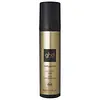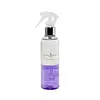What's inside
What's inside
 Key Ingredients
Key Ingredients

 Benefits
Benefits

 Concerns
Concerns

 Ingredients Side-by-side
Ingredients Side-by-side

Water
Skin ConditioningGluconolactone
Skin ConditioningPEG-40 Hydrogenated Castor Oil
EmulsifyingParfum
MaskingSodium Benzoate
MaskingSodium Laneth-40 Maleate/Styrene Sulfonate Copolymer
Bis-Isobutyl PEG/PPG-20/35/Amodimethicone Copolymer
Cetyl Ethylhexanoate
EmollientPanthenol
Skin ConditioningSodium Hydroxide
BufferingPolysorbate 80
EmulsifyingThermus Thermophillus Ferment
Skin ConditioningButylene Glycol
HumectantTetrasodium EDTA
Hydrolyzed Wheat Protein Pg-Propyl Silanetriol
Skin ConditioningPhenoxyethanol
PreservativeCalcium Gluconate
HumectantPotassium Sorbate
PreservativeGlycerin
HumectantBenzyl Salicylate
PerfumingCitral
PerfumingCitronellol
PerfumingCoumarin
PerfumingHexyl Cinnamal
PerfumingLimonene
PerfumingLinalool
PerfumingAlpha-Isomethyl Ionone
PerfumingWater, Gluconolactone, PEG-40 Hydrogenated Castor Oil, Parfum, Sodium Benzoate, Sodium Laneth-40 Maleate/Styrene Sulfonate Copolymer, Bis-Isobutyl PEG/PPG-20/35/Amodimethicone Copolymer, Cetyl Ethylhexanoate, Panthenol, Sodium Hydroxide, Polysorbate 80, Thermus Thermophillus Ferment, Butylene Glycol, Tetrasodium EDTA, Hydrolyzed Wheat Protein Pg-Propyl Silanetriol, Phenoxyethanol, Calcium Gluconate, Potassium Sorbate, Glycerin, Benzyl Salicylate, Citral, Citronellol, Coumarin, Hexyl Cinnamal, Limonene, Linalool, Alpha-Isomethyl Ionone
Water
Skin ConditioningCyclopentasiloxane
EmollientIsohexadecane
EmollientHexylene Glycol
EmulsifyingParfum
MaskingButyrospermum Parkii Butter
Skin ConditioningPersea Gratissima Oil
Skin ConditioningPoloxamer 184
EmulsifyingMorinda Citrifolia Fruit Extract
Skin ConditioningHelianthus Annuus Seed Oil
EmollientPanthenol
Skin ConditioningHydrolyzed Quinoa
Skin ConditioningGlycerin
HumectantPolysilicone-15
UV FilterGluconolactone
Skin ConditioningSodium Benzoate
MaskingCalcium Gluconate
HumectantCoumarin
PerfumingGeraniol
PerfumingBenzyl Benzoate
AntimicrobialHexyl Cinnamal
PerfumingAlpha-Isomethyl Ionone
PerfumingSodium Hydroxide
BufferingCI 60725
Cosmetic ColorantWater, Cyclopentasiloxane, Isohexadecane, Hexylene Glycol, Parfum, Butyrospermum Parkii Butter, Persea Gratissima Oil, Poloxamer 184, Morinda Citrifolia Fruit Extract, Helianthus Annuus Seed Oil, Panthenol, Hydrolyzed Quinoa, Glycerin, Polysilicone-15, Gluconolactone, Sodium Benzoate, Calcium Gluconate, Coumarin, Geraniol, Benzyl Benzoate, Hexyl Cinnamal, Alpha-Isomethyl Ionone, Sodium Hydroxide, CI 60725
Ingredients Explained
These ingredients are found in both products.
Ingredients higher up in an ingredient list are typically present in a larger amount.
Alpha-Isomethyl Ionone is a fragrance. It can be synthetically created or naturally occurring.
The scent of Alpha-Isomethyl Ionone is described as "flowery" but can also be "woody".
Naturally occurring Alpha-Isomethyl Ionone may be found in Saccharomyces cerevisiae, or the yeast used to make wine and bread.
The term 'fragrance' is not regulated in many countries. In many cases, it is up to the brand to define this term. For instance, many brands choose to label themselves as "fragrance-free" because they are not using synthetic fragrances. However, their products may still contain ingredients such as essential oils that are considered a fragrance.
Learn more about Alpha-Isomethyl IononeThis ingredient is calcium salt of gluconic acid. It is a humectant, meaning it attracts water to your skin.
Coumarins are a group of substances found naturally in plants. There are over 1300 types of coumarins identified. It has a natural vanilla scent.
Coumarin is an identified EU known allergy, meaning it may cause an allergic reaction when applied to the skin.
In many countries, coumarin is banned as a food additive. However, it can be found in soaps, tobacco products, and some alcohol drinks.
Plants use coumarins as a chemical defense. Some plants that have coumarins include lavender, tonka beans, and yellow clovers.
Learn more about CoumarinGluconolactone is a PHA. PHAs are a great gentle alternative to traditional AHAs.
When applied, Gluconolactone has the same affect on skin as AHAs such as lactic acid. It helps dissolve the dead skin cells in the top layer of your skin. This improves texture and brightens the skin.
PHAs are more gentle than AHAs due to their larger structure. They do not penetrate as deeply as AHAs and take a longer time to dissolve dead cells. Studies show PHAs do not cause as much irritation.
Gluconolactone has some interesting properties:
In a 2004 study, Gluconolactone was found to prevent UV damage in mouse skin cells and has not been found to increase sun sensitivity. However, we still recommend wearing SPF daily.
This ingredient is is an created by reacting gluconic acid with an alcohol.
Learn more about GluconolactoneGlycerin is already naturally found in your skin. It helps moisturize and protect your skin.
A study from 2016 found glycerin to be more effective as a humectant than AHAs and hyaluronic acid.
As a humectant, it helps the skin stay hydrated by pulling moisture to your skin. The low molecular weight of glycerin allows it to pull moisture into the deeper layers of your skin.
Hydrated skin improves your skin barrier; Your skin barrier helps protect against irritants and bacteria.
Glycerin has also been found to have antimicrobial and antiviral properties. Due to these properties, glycerin is often used in wound and burn treatments.
In cosmetics, glycerin is usually derived from plants such as soybean or palm. However, it can also be sourced from animals, such as tallow or animal fat.
This ingredient is organic, colorless, odorless, and non-toxic.
Glycerin is the name for this ingredient in American English. British English uses Glycerol/Glycerine.
Learn more about GlycerinHexyl Cinnamal is a fragrance ingredient with a similar scent to jasmine. It can be naturally found in chamomile essential oil.
This ingredient is a known EU allergen and may sensitize the skin. The EU requires this ingredient to be listed separately on an ingredients list.
Hexyl Cinnamal is not water soluble but is soluble in oils.
Learn more about Hexyl CinnamalPanthenol is a common ingredient that helps hydrate and soothe the skin. It is found naturally in our skin and hair.
There are two forms of panthenol: D and L.
D-panthenol is also known as dexpanthenol. Most cosmetics use dexpanthenol or a mixture of D and L-panthenol.
Panthenol is famous due to its ability to go deeper into the skin's layers. Using this ingredient has numerous pros (and no cons):
Like hyaluronic acid, panthenol is a humectant. Humectants are able to bind and hold large amounts of water to keep skin hydrated.
This ingredient works well for wound healing. It works by increasing tissue in the wound and helps close open wounds.
Once oxidized, panthenol converts to pantothenic acid. Panthothenic acid is found in all living cells.
This ingredient is also referred to as pro-vitamin B5.
Learn more about PanthenolParfum is a catch-all term for an ingredient or more that is used to give a scent to products.
Also called "fragrance", this ingredient can be a blend of hundreds of chemicals or plant oils. This means every product with "fragrance" or "parfum" in the ingredients list is a different mixture.
For instance, Habanolide is a proprietary trade name for a specific aroma chemical. When used as a fragrance ingredient in cosmetics, most aroma chemicals fall under the broad labeling category of “FRAGRANCE” or “PARFUM” according to EU and US regulations.
The term 'parfum' or 'fragrance' is not regulated in many countries. In many cases, it is up to the brand to define this term.
For instance, many brands choose to label themselves as "fragrance-free" because they are not using synthetic fragrances. However, their products may still contain ingredients such as essential oils that are considered a fragrance by INCI standards.
One example is Calendula flower extract. Calendula is an essential oil that still imparts a scent or 'fragrance'.
Depending on the blend, the ingredients in the mixture can cause allergies and sensitivities on the skin. Some ingredients that are known EU allergens include linalool and citronellol.
Parfum can also be used to mask or cover an unpleasant scent.
The bottom line is: not all fragrances/parfum/ingredients are created equally. If you are worried about fragrances, we recommend taking a closer look at an ingredient. And of course, we always recommend speaking with a professional.
Learn more about ParfumSodium Benzoate is a preservative. It's used in both cosmetic and food products to inhibit the growth of mold and bacteria. It is typically produced synthetically.
Both the US FDA and EU Health Committee have approved the use of sodium benzoate. In the US, levels of 0.1% (of the total product) are allowed.
Sodium benzoate works as a preservative by inhibiting the growth of bacteria inside of cells. It prevents the cell from fermenting a type of sugar using an enzyme called phosphofructokinase.
It is the salt of benzoic acid. Foods containing sodium benzoate include soda, salad dressings, condiments, fruit juices, wines, and snack foods.
Studies for using ascorbic acid and sodium benzoate in cosmetics are lacking, especially in skincare routines with multiple steps.
We always recommend speaking with a professional, such as a dermatologist, if you have any concerns.
Learn more about Sodium BenzoateSodium Hydroxide is also known as lye or caustic soda. It is used to adjust the pH of products; many ingredients require a specific pH to be effective.
In small amounts, sodium hydroxide is considered safe to use. However, large amounts may cause chemical burns due to its high alkaline.
Your skin has a natural pH and acid mantle. This acid mantle helps prevent harmful bacteria from breaking through. The acid mantle also helps keep your skin hydrated.
"Alkaline" refers to a high pH level. A low pH level would be considered acidic.
Learn more about Sodium HydroxideWater. It's the most common cosmetic ingredient of all. You'll usually see it at the top of ingredient lists, meaning that it makes up the largest part of the product.
So why is it so popular? Water most often acts as a solvent - this means that it helps dissolve other ingredients into the formulation.
You'll also recognize water as that liquid we all need to stay alive. If you see this, drink a glass of water. Stay hydrated!
Learn more about Water